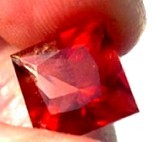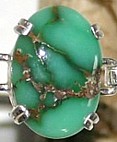
Treatment of Ruby and Sapphire Gems

 |
Treatment of Ruby and Sapphire Gems
|
 |
The
mineral corundum also known as aluminum oxide, is one of the best known of all gems. When pure it is colorless but it is often colored
by the presence of various transition metals and color center crystal imperfections. When
found in a red color, the mineral corundum is known as Ruby this is usually caused by the
presence of the element chromium. All colors
other than red are known as Sapphire. A
large variety of heat treatment processes are used in processing corundum. Oils, glasses and other fillings are also
sometimes used, especially in Ruby. Occasionally irradiation is used, but most irradiation
induced corundum colors are temporary and quickly fade in the sunlight. The most common radiation-induced color is a
yellow to gold tone. Heat
to a temperature between 1500 and 1700° centigrade in an oxidizing atmosphere tend to
induce a moderate to deep yellow color in pale sapphires.
In deep dark blue sapphires, the same process tends to lighten these dark
blue sapphires to a depth of coloration which is more desirable. This occurs when iron is converted from the plus
two valence to a plus three state. In dark
blue sapphires it may also induce the same conversion at times adds a greenish tone when
the yellow is added to the blue. The colors produced by these processes is stable and
permanent. Heat
to a similar temperature of between 1500 and 1700° centigrade in an reducing atmosphere
tends to induce the desirable medium Sapphire blue color in many pale colored sapphires. A number of Sapphire deposits produce such pale
stones, including some of the Sapphire deposits in Montana.
Much more attractive, well colored stones can be created in this process. It can greatly increase the value of the
undesirable pale colored stones. The colors produced by these processes is stable and
permanent. Heat
between 1600 and 1900°C for an extended period of time will actually induce silk in
stones which contain sufficient titanium in their chemical make up. During this extended
heat, the titanium oxide precipitates out as tiny needles which create the star stone
effect. This can turn an otherwise clear
stone into a star sapphire Ruby. Heat
between 1600 and 1900°C for a brief period of time will allow some types of inclusions to
be reabsorbed or re-dissolved into the crystal structure.
This type of process reduces silk and can eliminate some types of
inclusions, including hairline fractures. It is most commonly practiced with Ruby. Additionally,
there are several heating techniques which infuse additional new elements into the
corundum Crystal structure. The first of
these used heat to add titanium oxide, in order that a Sapphire blue color could be
created. Generally these impregnation's are
very shallow and penetrate the surface of the crystal only a few thousandths of an inch of
thickness. More recently processes have been
developed to add beryllium to the crystal structure inducing and beautiful padparadscha
pink orange coloration. |
|
The
treatment of Ruby and Sapphire is a delicate art requiring considerable practice and
effort a few operators have taken the time to learn all the techniques that have mastered
this art. Finally,
many rubies and some sapphires are treated with glasses or oils to hide cracks and flaws
and improve the apparent clarity of the stone. Unfortunately, the materials which are used
to fill the voids are not nearly as strong or stable as the gemstone itself. Stones which were weak through the presence of
cracks and other flaws do not become appreciably stronger through the process of filling
them, and any structural weakness that was originally present still remains. |
|
|
Want to know a little bit more about this crazy prospector guy? Well, here's a little bit more about me, and how I got into prospecting: Chris' Prospecting Story